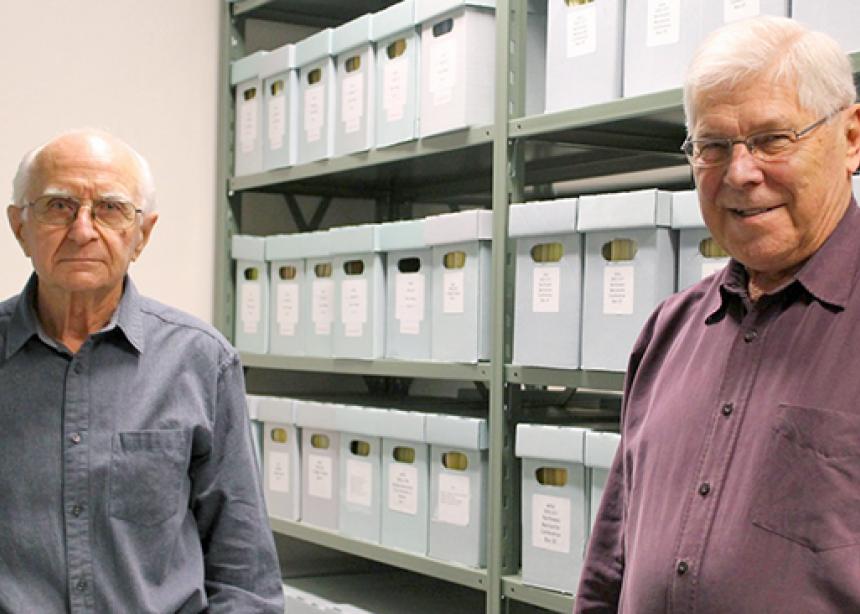Hearing the word “archives” may conjure sneeze-worthy stereotypes. However, a visit to the Mennonite Historical Society of Alberta Archives in Calgary quickly dispels any dusty images.
A crowd of lively volunteers surrounded by history laugh around the lunch table, sharing discoveries made during their weekly volunteer stint to preserve the history of Mennonites in Alberta.
One day last fall, that work included sorting through a wealth of Mennonite Church Alberta files donated by Henry Goerzen of Didsbury; reading and organizing sermon notes from Peter Schellenberg, pastor of Coaldale Mennonite church in the 1930s; eliminating duplicate copies of old publications; organizing financials and files on the computer; and taking one wide-eyed, question-filled Canadian Mennonite reporter into the vault.
A temperature- and humidity-controlled room, the vault is filled with sky-blue, acid-free file boxes neatly organized on rolling shelves.
“This is heaven,” Ted Regehr joked.
The vault is where files come after having languished in “purgatory,” a crammed storage room where boxes and files of material await evaluation. Regehr, a volunteer archivist for the Historical Society, has a wealth of experience with archives both as a published historian and having worked at the National Archives in Ottawa for eight years.
The largest collections currently housed by the Historical Society Archives are those of MC Alberta, the Northwest Conference and Mennonite Central Committee. While there are a number of congregations represented, the collection is far from complete. Regehr would love to make a tour of Alberta churches to search for materials, but staffing, volunteer time and available space are limiting factors.
“We haven’t really solicited things,” Regehr said. “We take what people offer.”
The Archives also house a number of family histories and letters. Exciting recent acquisitions include several small collections of letters from the 1920s and ’30s, sent by people in Russia to their relatives in Alberta. The letters present a special challenge, as many are written in Gothic German script that few volunteers can decipher. Such collections can be valuable additions to the Archives.
“There’s a good reason that archivists are sometimes know as hearse chasers,” Regehr said. It is “a critical time when people die, to find out what materials people have. Children often don’t know what to do with those.”
Among the materials people are often at a loss about what to do with are things like sermon notes from years gone by, which, Regehr said, “provide a window into issues that concerned people at that time. It is also important to note what was never mentioned,” he added.
Peter Dyck, tasked with sorting some of these notes, commented: “I have an interest in our history that I’ve had for a long time. . . . A lot of times you get to reading this stuff and it’s very interesting. I know a lot of the people!”
Occasionally stories surface that seem hilarious today. A documented discussion of the perceived ethical trespass of a pastor allegedly reusing a postage stamp is “the most ridiculous one I’ve found,” said volunteer Bill Janzen.
Of impact of the digital age on the preservation of history, Regehr said, “I’m not sure anyone in archives has gotten a good handle on it. . . . A lot of things can be preserved digitally, but then we constantly have to update [the technology] because everything gets obsolete.”
“Everything today seems to move so quickly,” Janzen added. “We seem to be losing connection with the past. This is very important.”
Pictures, although valuable, can be particularly difficult to archive. For photos to be archive-worthy, the source, date, occasion, place, image quality, reason for interest and the names of subjects are all important considerations.
Volunteers at the archives have compelling reasons for giving their time every Thursday.
Alice Unrau is interested in history and loves working with computers; when she heard computer skills were needed at the archives, the fit was right for her.
Lil Bartel is interested in family history, and enjoys inspiring the same interest in others by working with Grade 9 student projects at Menno Simons Christian School in Calgary.
Ralph Dahl said, “For me, it’s fascinating. . . . Anybody that likes history would have a good time here. This is my mission work.” But while the work of the Archives is both important and rewarding, “we can’t keep up,” Dahl said.
A current need is for volunteers with library experience. Jim Bowman, previously hired once per month as a consultant in this area, now volunteers his time. “It was his Christmas gift,” according to Regehr.
Current needs are for individuals and churches to send historical materials to the Archives, for more volunteers, and for donations to bolster the very small budget for this church work.
The Mennonite Historical Society of Alberta Archives (www.mennonitehistory.org/archive) are open Thursdays from 10 a.m. to 4 p.m. Special appointments are also available on request.




Add new comment
Canadian Mennonite invites comments and encourages constructive discussion about our content. Actual full names (first and last) are required. Comments are moderated and may be edited. They will not appear online until approved and will be posted during business hours. Some comments may be reproduced in print.